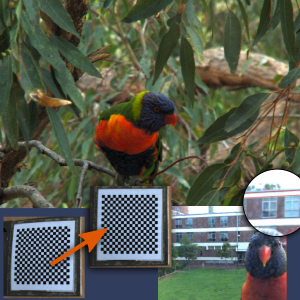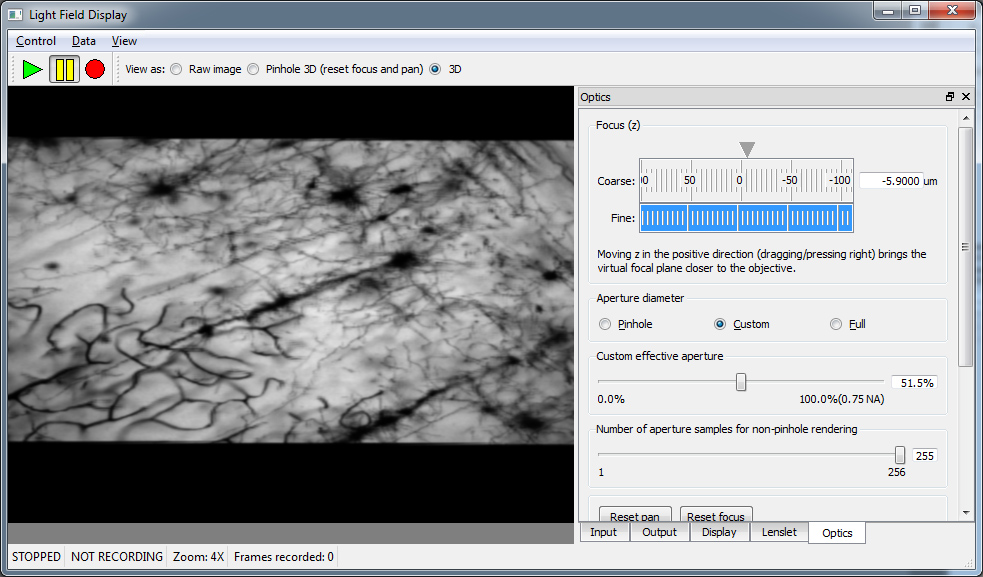Light Field Toolbox 0.4 adds Linear Depth/Focus and Denoising Filters
 If you’ve been following the development of the Light Field Toolbox for Matlab, please note that the author has released an update with new features: Light Field Toolbox v0.4 builds upon the previous version and adds linear depth/focus and denoising filters for light field pictures.
If you’ve been following the development of the Light Field Toolbox for Matlab, please note that the author has released an update with new features: Light Field Toolbox v0.4 builds upon the previous version and adds linear depth/focus and denoising filters for light field pictures.
For more technical information regarding these filters and their use, please refer to the following upcoming publication: D.G. Dansereau, O. Pizarro, and S. B. Williams, “Linear Volumetric Focus for Light Field Cameras,” to appear in ACM Transactions on Graphics (TOG), vol. 34, no. 2, 2015.
As always, you may download the current version and corresponding Light Field Sample Pack via the links below, or head over to the project page for more information:
 Light Field Toolbox v0.4 (977.1 KiB, 4,305 hits)
Light Field Toolbox v0.4 (977.1 KiB, 4,305 hits)
 Light Field Sample Pack for LightField Toolbox v0.3 and v0.4 (386.5 MiB, 3,884 hits)
Light Field Sample Pack for LightField Toolbox v0.3 and v0.4 (386.5 MiB, 3,884 hits)
New functions in this version:
LFBuild2DFreqFan – construct a 2D fan passband filter in the frequency domain
This file constructs a real-valued magnitude response in 2D, for which the passband is a fan.
LFBuild2DFreqLine – construct a 2D line passband filter in the frequency domain
This file constructs a real-valued magnitude response in 2D, for which the passband is a line. The cascade of two line filters, applied in s,u and in t,v, is identical to a 4D planar filter, e.g. that constructed by LFBuild4DFreqPlane.
LFBuild4DFreqDualFan – construct a 4D dual-fan passband filter in the frequency domain
This file constructs a real-valued magnitude response in 4D, for which the passband is a dual-fan, the intersection of 2 2D fans.
LFBuild4DFreqHypercone – construct a 4D hypercone passband filter in the frequency domain
This file constructs a real-valued magnitude response in 4D, for which the passband is a hypercone.
LFBuild4DFreqHyperfan – construct a 4D hyperfan passband filter in the frequency domain
This file constructs a real-valued magnitude response in 4D, for which the passband is a hyperfan. This is useful for selecting objects over a range of depths from a lightfield, i.e. volumetric
focus.
LFBuild4DFreqPlane – construct a 4D planar passband filter in the frequency domain
This file constructs a real-valued magnitude response in 4D, for which the passband is a plane. This is useful for selecting objects at a single depth from a lightfield, and is similar in effect to refocus using, for example, the shift sum filter LFFiltShiftSum.
LFDemoBasicFiltGantry – demonstrate basic filters on stanford-style gantry light fields
Generates and displays a set of filtered light field images as separate figures. Demonstrates the shift sum filter and 4D planar and 4D hyperfan linear filters.
LFDemoBasicFiltIllum – demonstrate basic filters on illum-captured imagery
Generates and displays a set of filtered light field images as separate figures. Demonstrates the shift sum filter and 4D planar and 4D hyperfan linear filters.
LFDemoBasicFiltLytroF01 – demonstrate basic filters on Lytro-F01-captured imagery
Generates and displays a set of filtered light field images as separate figures. Demonstrates the shift sum filter and 4D planar and 4D hyperfan linear filters.
LFDisp – Convenience function to display a 2D slice of a light field
The centermost image is taken in s and t. Also works with 3D arrays of images. If an output argument is included, no display is generated, but the extracted slice is returned instead.
LFFilt2DFFT – Apply a 2D frequency-domain filter to a 4D light field using the FFT
This filter works on 2D slices of the input light field, applying the 2D filter H to each in turn. It takes the FFT of each slice of the input light field, multiplies by the provided magnitude response H, then calls the inverse FFT.
LFFiltShiftSum – a spatial-domain depth-selective filter, with an effect similar to planar focus
This filter works by shifting all u,v slices of the light field to a common depth, then adding the slices together to yield a single 2D output. The effect is very similar to planar focus, and by controlling the amount of shift one may focus on different depths. If a weight channel is present in the light field it gets used during normalization.






Recent Comments